Telangana SCERT 8th Class Social Guide Telangana 13th Lesson The Indian Constitution Textbook Questions and Answers.
TS 8th Class Social 13th Lesson Questions and Answers – The Indian Constitution
Improve Your learning
Question 1.
‘Damanpur’ is ruled by its king based on a set of rules written down by the priest and ministers. He has also divided his kingdom into 16 provinces to which he appoints his officers as governors. Can we say that this is democratic country? Is it a constitutional country Give reasons for your answer.(Conceptual understanding)
Answer:
Damanpur is not a democratic country because the people were not involved in electing their representatives. Yes. It is a constitutional country because certain rules are set up according to which the country functions.
Question 2.
Which of the following statement is correct? (Conceptual understanding)
a) Constitution determines the relationship between people and government.
b) Democratic countries generally contain a Constitution.
c) To make a Constitution to a diverse country like India is not an easy task.
d) All are correct.
Answer:
Option “d” is correct.
Question 3.
Read again the extracts from Nehru’s speech and answer the following: (Reading the text (given), understanding and interpretation)
That Future is not one of ease or resting but of incessant striving so that roe may fulfill the pledges we have so often taken and the one we shall take today. The service of India means the service of the millions who suffer. It means the ending of poverty anti ignorance and disease and inequality of opportunity, The ambition of tire greatest man of our generation has been to wipe every tear from every eye. That may be beyond us, but as
long as there are tears and suffering, so long our work will not be over. – Jawaharlal Nehru
a) What pledge did he want the makers of the Indian Constitution to take?
Answer:
Jawaharlal Nehru wants the makers of the Indian Constitution to pledge that they would provide their service to millions of Indians who are suffering.
b) “The ambition of the greatest man of our generation has been to wipe every tear from every eye.” Who was he referring to?
Answer:
Mahatma Gandhi.
Question 4.
What values are embedded in the preamble of Indian Constitution? (C.U)
Answer:
Secularism, democracy, justices equality, liberty, and fraternity one the values embedded in the preamble of Indian constitution.
![]()
Question 5.
“All are equal before law”. Explain this with examples. (C.U)
Answer:
- Our Indian Constitution seeks to ensure that all people with envoy equal status that is everyone is governed by same laws.
- No one is superior to other based on caste, colour, religion or wealth.
- In 2G Spectrum case, allowing some special benefits to some companies, ministers are arrested and imprisoned.
- In coalgate scam, the then ministers were enquired. All this shows that none are great before law and all are equal.
Question 6.
Identify correct statements from the following: (Conceptual understanding)
a) The Constitution defines powers of the Legislative houses.
b) The Constitution cannot be changed under any circumstances.
c) Ideals that are in the preamble are reflected in the design of institutions.
d) Laws for the entire country are designed centrally.
Answer:
The correct statements are a), c), d)
Question 7.
On what occasions equal justice is seen? Mention with examples. (Appreciation and Sensitivity)
Answer:
Our Constitution seeks to ensure that all people enjoy the same status. There is no more importance to a rich person or less importance to a poor person. Our constitution promises equality of opportunity in public jobs. It means all public offices shall be open to all irrespective of caste or religion.
Examples:
- We find equal justice in case of legal disputes. The two parties of the dispute are heard and justice is done.
- Equal justice is seen in case of disputes among religions, castes, or gender.
Project
Question 1.
Compare the preambles to the Constitutions of the United States of America, India, and South Africa.
a. Make a list of ideals that are common to all these three.
Answer:
Democracy, equal justice, equality, and liberty.
b. Note down at least one major difference among these.
Answer:
- In Indian preamble, the word ‘secular’ got a mention whereas in the preambles of in U.S.A And South Africa, there is no mention of this word.
- In the preamble of U.S.A and India, there is no mention of ‘God’. It is mentioned in the preamble of South Africa.
c. Which of the three makes a reference to the past?
Answer:
South Africa,
d. Which of these does not Invoke God?
Answer:
U.S.A and India.
Intext Questions
Text Book Page No. 151
Question 1.
Why did not the leaders who fought for freedom want India to be ruled by kings and queens? (Conceptual understanding)
Answer:
Our leaders fought against the British colonial rule because they wanted the future government of India to be democratic and not monarchic. They wanted India to be ruled by the people thernsclve% with the help of elected representatives.
Question 2.
If you and your classmates were asked to formulate five goals for the country — what would they be? How would you arrive at those five goals? Discuss in the class and work with the help of your teacher.
Answer:
The five goals which we would formulate for the country:
- Eradication of poverty.
- Safety for women.
- Free medical facilities for everybody.
- Putting an end to corruption.
- Putting an end to terrorism
Arriving goals.
- By representations to elected representatives.
- By creating awareness in the public.
- By raising a voice against the atrocities.
Text Book Page No. 152
Question 3.
Find out from your grandparent% or old neighbours who were there at the time of independence about how things were at that time and what they felt about the future of the country. (Conceptual understanding)
Answer:
| Before Independence | After Independence |
| ‘People lived with fear of English rulers that imposed craw taxes on agriculture, most jobs were for the English monarchy. | People made the Government and peace ensured. |
| Radio was the means of mass communication. | TV, phone and internet are the main tools of communication today. |
| Culturally, people were honest and fearless in their talk. | People today are more dishonest and connive lot for selfish reasons. |
| Modem courtship and sexuality was considered taboo. | It is common for things like love and sex to be talked about even though the movie industry will censor a lot of the things said. |
| Education was not mandatory, Women almost never went to school. | Primary education made compulsory, women’s education was made priority. |
| Finishing up your 10th grade and Bachelor’s was the biggest achievement and it was all local education. | Master’s degrees and Professional education have become the norm today. |
| Transport was usually walked, bullock carts, and bicycles. Trains were not an option for Indians for reasons of affordability and discrimination. | Every middle-class family these days owns a car and or at least a two-wheeler. Buses and trains run aplenty, air transport is increasingly common. |
| People saw more incidences of Sati (an act where a widow was Forced or voluntarily thrown into the burning funeral pyre of her husband), female infanticide, caste system where the “untouchables” were discriminated in entering public places and enjoying rights. | Today religion has seen a drastic change – Sati no more exists, lower infanticides, caste system reversal- still an inequality since the lower castes” enjoy superior benefits in academic seats and jobs. |
The people were positive about the future of the country because they believed in their leaders and hoped that one day India would be free country.
![]()
Question 4.
Can you list out some of the inequalities and discriminations prevalent in our society at the time of Independence? (Conceptual understanding)
Answer:
Following inequalities and discriminations were prevalent in our society at the time of Independence:
- Gender-based inequality.
- Caste-based discrimination.
- Educational inequalities.
- Employment discrimination.
Question 5.
Here is a set of statements that is put in pairs, but some of it has wrong information. Can you correct them? (Conceptual understanding)
a) A model constitution was drafted – Motilal Nehru.
b) leaders agreed that illiterate people should not vote + universal adult franchise.
c) Provincial legislature + Constitution adopted some colonial laws.
d) Partition + large number of people were killed and forced to migrate.
e) Restriction on women voting + commitment to social reform in India.
Answer:
The incorrect statements are b, e.
Correct Statements:
b and e: According to the universal adult franchise, every adult citizen irrespective of gender, caste, religion, education or wealth has the right to vote in elections.
Text Book Page No. 153
Question 6.
What were the sources of inspiration and ideas for framing our Constitution?
Answer:
- Americal Rights Act.
- Socialist revolution in Russia and China.
- Parliamentary democracy of Britain.
Question 7.
Why do you think were the kings allowed to nominate members to the Constituent Assembly? (Conceptual understanding)
Answer:
By the time we got independence, some parts of the country were under the rule of kings. They too wanted to express their opinions in preparing the constitution as some of them wanted to merge in the country and some to have special rights. Hence the kings were allowed to nominate members to express their views.
Question 8.
Why do you think were there very few women members Do you think it would have been better if there had been more women members? (Reflection on contemporary issues and questioning)
Answer:
In earlier days, women were not given the freedom to come out of their houses and participate in activities along with men. Male domination suppressed the participation of women in the Constituent Assembly. Hence, there were very few women members in the Constituent Assembly. Yes. It would have been better if there had been more women members because it would encourage other women to participate in developing the country.
Text Book Page No. 155
Question 9.
Which of the guiding principles in the Objeclise Resolution do you think is the most important? Give your reasons for It Do other students have a different opinion about this? (Conceptual understanding)
Answer:
According to me, the guiding principle of justice, equality, and freedom to everybody is the most important one because it helps in building up a secular country. India is a country where. people of different religions and races live together. in inch a country. equality amongst different races of people is a must to we peacefully.
All citizens should be provided justice irrespective of their caste or community. Every human has the right to be born free and express his thoughts. follow his choice of religion etc. No student in our days has different opinion about this.
Text Book Page No. 156
Question 10.
Can you identify one idea that is common to all these three (M.K. Gandhi, Dr.B.R. Ambedkar, and J. Nehru? (Conceptual understanding)
Answer:
The Idea which is common to all the three is the idea of equality.
Question 11.
What are the differences In their ways of expressing that common idea? (Conceptual understanding)
Answer:
In the view of Mahatma Gandhi, “The poorest shall feel that it us their country in whose making they have an effective voice; an India in which there shall be no high class and low class of people and they shall live in perfect harmony.
Dr. BR. Ambedkar thought that in politics it will have equality, and in social and economic life due to our social economic structure we will have equality. How long shall we continue to deny equality. It means Dr. Ambedkar had a strong opinion In rental ing inequalities. Jawaharlal Nehru said that. the service of India means the service of the millions who suffer. It means the ending of poverty, ignorance, disease, and inequality of opportunity.
Question 12.
The people of India decided (‘resolved’) to achieve two objectives. What were these?
Answer:
- To make India a republic
- To secure all its, justice, liberty, equality, and fraternity.
Question 13.
What did they do in order to achieve these objectives?
Answer:
To achieve these objectives
- The head of the state is elected in democratic way and hereditary is stopped
- Socialism and secularism are adopted Fundamental Rights are granted and guaranteed.
Text Book Page No. 158
Question 14.
Why is it necessary for an elected parliament to make laws? Why can’t they be made by learned lawyers and judges? (Conceptual understanding)
Answer:
Since India is a democratic country, the laws to be implemented by the government should be formulated by the representatives elected by the people of India. Hence learned lawyers and judges cannot formulate laws. Judiciary was formed to project the laws.
Question 15.
Why do you think should the Prime Minister and his Cabinet get their decisions and actions approved by the Parliament and answer the questions raised by the members of Parliament? Will it be better if they were answerable only to the President? (Conceptual understanding)
Answer:
The Parliament, consisting of representatives of the people makes laws. Hence it is better that Prime Minister and his Cabinet should get their decisions and actions approved by the Parliament rather than President only.
![]()
Text Book Page No. 159
Question 16.
Some countries have a different structure, in which there is only a central government which makes laws for the entire country and governs all the provinces or states. Do you think such a system is suited for India? Discuss in the class. (Appreciation and Sensitivity)
Answer:
Only a central government which makes laws for the entire country and governs all the provinces or states are not suitable for India because the territory of the India is too big, populated, and varying to be governed by a single body.
Question 17.
Discuss why the courts and judges should be independent of the state and central government authorities.
Answer:
Judicial independence is the concept that the judiciary needs to be kept away from the other branches of government. That is, courts should not be subjected to improper influence from the other branches of government or from private or partisan interests. Judicial Independence is vital and important to the idea of separation of powers.
Question 18.
Why should the Election Commission be autonomous? (Conceptual understanding)
Answer:
The Election Commission should be autonomous in order to conduct Free and fair elections.
Appreciation & Sensitivity
Write few lines about the people in the following pictures.
Answer:
1. Sarojini Naidu:
Sarojini Naidu, also known by the sobriquet. The Nightingale of India, was a child prodigy, Indian independence activist, and poet. Naidu was one of the framers ot the Indian Constitution. Naidu is the second Indian woman to become the President of the Indian National Congress and the first woman to become the Governor of Uttar Pradesh state. Her birthday is celebrated as Women’s Day all over India.
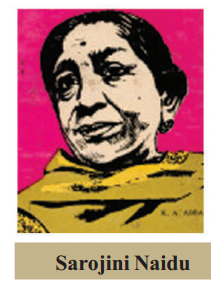
2. Durgabai Dechmukh:
Durgabai. Deshmukh (July 15. 1909 . May 9, 1981) was an Indian freedom fighter, lawyer, social, worker, and politician. She was a member of the Constituent Assembly of India and the [Planning Commission of India]. Born in Kakinada, Andhra Pradesh, India. Durgabai was married at the age of 14 to a Telugu person, later left, and married C.D. Deshmukh, the first Indian Governor of the Reserve Bank of India and Finance Minister in India’s Central Cabinet during 1950. 1956.
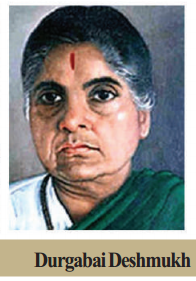
She was a public activist for women’s emancipation,also founder of Andhra Mahila Sabha, Congress. She was also the founder chair person of Central Social Welfare Board.
3. N.G.Ranga:
Gogineni Ranganavukulu . better known as N. G. Ranga (7 November 1900- 9 June 1995). was an Indian Freedom fighter, parliamentarian, and Kisan (farmer) leader. He was an exponent of the peasant philosophy and is considered as the father of the Indian Peasant Movement after Swami Sahajanand Saraswati.
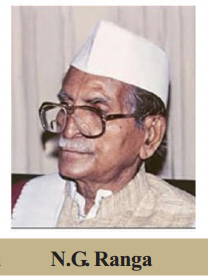
4. T. Prakasam:
Tanguturi Prakasam Pantulu (23 August 1872 – 20 May 1957) was an Indian politician and Freedom Fighter and the first Chief Minister of the Indian province Andhra state. He was also known as Andhra Kesari (literally, the Lion of Andhra).
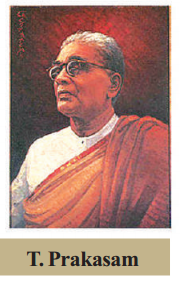
Additional Questions
Question 1.
Our constitution consists of many values. All should inculcate them. But to what extent these are inculcated in the society nowadays What might be the reasons
Answer:
Our constitution consists of many values like justice, liberty, equality, fraternity, and secularism. But, many of them are disappearing from the society. The reasons are: growing casteism. non-tolerance to other religions, corruption, selfishness, domination of money in elections, etc.
Question 2.
Which aspects of the dreams and promises can you identify in the words used in preamble Create a chart to show the relationships. (Appreciation and Sensitivity)
Answer:
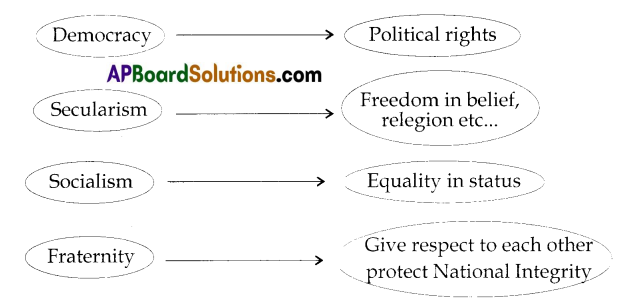
Question 3.
Read the box item ‘Preamble of our Constitution’ in the text page no. 156. What are the values incorporated in it? Explain about each value in your own words.
WE, THE PEOPLE OF INDIA, Juwing Solemnly resolved to constitute India into a SOVEREIGN. SOCIALIST. SECULAR, DEMOCRATIC REPUBLIC and to secure to all its citizens: JUSTICE, social, economic and political; LIBERTY of thought, expression, belief; faith and worship; EQUALITY of status and of opportunity: And to promote among them all FRATERNITY assuring the dignity of the individual and the unity and integrity of the nation; IN OUR CONSTITUENT ASSEMBLY This twenty-sixth day of November 1949, do HEREBY ADOPT, ENACT AND GIVE TO OURSELVES THIS CONSTITUTION.
Answer:
Values incorporated in Preamble
SECULAR: The government will not be run on the basis of any religion. Citizens will have complete freedom to follow any religion or no religion at all. Government will not favour any religion.
DEMOCRATIC: A form O government where people enjoy equal political rights, elect their representatives to make laws and run the government and hold the representatives accountable.
JUSTICE: All citizens should get what is their due No discrimination will he made on account of their birth or beliefs or wealth or status.
EQUALITY: Our Constitution seeks to ensure that all people will enjoy the same status -that is every one will be governed by the same laws. Secondly, it promises equality of opportunity.
LIBERTY: There will be no unreasonable restrictions on the citizens in what they think, how they wish to express their thoughts, and the way they wish to follow up their thoughts in action or come together to form associations or parties.
FRATERNITY; To build a sense of bonding and unity among all people. No one should treat a fellow citizen as inferior or as an alien stranger.
![]()
Question 3.
Prepare a few slogans on the values prescribed in the Preamble of the Constitution to be practiced by everyone. (Appreciation and Sensitivity)
Answer:
- Our country is sovereign – We strive hard to keep it shine.
- Our country is secular- We keep the religious bios at a distance forever.
- Socialist economy Strive, we, to reduce inequality.
- Democracy is the form of our government – Ruled by representatives that people elect.
- Justice to all irrespective of caste, colour, creed, or status- All citizens get their due share is the essence.
- Equality before law – Let us keep it without any flaws.
- Liberty to follow the religion one wishes and express one’s thoughts – The theme of Indians that makes future bright.
- Fraternity to build a sense of bonding – That keeps Indian glory standing.
Reading the Text (given), understanding and interpretation
A) “A Constitution is a set of rules about how tire country should be governed – how the laws that run it would be made or changed, how the government should fromed, what would be the role of the citizens, what would be their rights etc. Above all the Constitution sets before the country the goals for which the country has to strive.”
Read the above paragraph “A constitution is a ……….. has to strive’ and answer the following question.
What Is the first purpose that Constitution serves?
Answer:
- Constitution lays out certain ideals forming the basis of the kind of country that citizens aspire to live in.
- It tells us about the fundamental nature of society.
- The constitution is a set of rules and principles that all persons in a country agree.
B) “The Constitution also provides institutional arrangments for ruling the country in accordance with the above ideals and values.” it provides for a Parliamentary form of government. The Parliament, consisting of
representatives of the people makes laws. The laws are implemented by a government formed from among the members of the Parliament and answerable to the parliament. The country is governed by the Cabinet headed by the Prime Ministries and the entire government is leaded by the President.
Read the above paragraph “The constitution ……………………… by the president” and answer the following question. ‘What would happen if there were no restrictions on the power of elected representatives?
Answer:
- These leaders or representatives might misuse their authority.
- This misuse of authority can result in gross injustice and dismanagement.
C) Read the section ‘Dream and Promise’ again.
The Dream and the Promise:
Let us begin by understanding the overall philosophy of what our Constitution is all about. We can understand it by reading the views of some of our major leaders on our Constitution. But it is equally important to read what the Constitution says about its own philosophy. The preamble of the Constitution states its philosophy.
Some of you may have noticed a name missing from the sketches of the makers of the Constitution: Mairatma Gandhi. He was not a member of the Constituent Assembly. Yet there were rira ni, members u’hrofoilou’ed iris vision. lVritimrg in the magazine Young India in 1931, he had spelt out what he wanted the Constitution to do:
I shall strive for a Constitution which will release India from all thraldom, and patronage… I shall work for an India in which the poorest shall feel that it is their country in whose making they have an effective voice an India in which there shall be no high class and low class of people; an India in which all communities shall live in perfect harmony.
There can be no room in such an India for the curse of untouchability or the curse of the intoxicating drinks and drugs. Women will enjoy the same rights as men …………. I shall he satisfied with nothing else. – Mahatma Gandhi.
This dream of an India without inequality was shared by Dr. Ambedkar who played a key role in the making of the Constitution. But he had a different understanding of how inequalities could be removed. in his concluding speech to the Constituent Assembly, he slated his anxiety very clearly:
On the 26th of January 1950, we are going to enter life of contradictions. In politics we will have equality and in social and economic life we will have inequality. In politics, we will be recognising the principle of one man one vote, and one vote one value. In our social and economic life we shall, by reason of our social and economic structure, continue to deny the principle of one man one value.
How long shall we continue to live this life of contradictions? How long shall we continue to dens, equality in our social and economic life? If we continue to deny it for long, we will do so only by putting our political democracy in peril. – Dr. B. R. Ans tiedkar
Finally let us turn to Jawaharlal Nehru giving his famous speech to the Constituent Assembly at the strike of midnight on August 25, 2947:
That future is not one of ease or resting hut of incessant striving so that ire may fulfill the pledges we have so often taken and the one we shall take today. Tite service of India means the service of the millions who suffer. It means the ending poverty and ignorance and disease and inequality of opportunity.
The ambition of the greatest man of our generation has been to wipe every tear from every eye. That may be us yond us, but as long as there are tears and suffering, so long as there are tears and suffering, so long our work will not be over – Jawaharlal Nehru Draw a table with statements that you consider as a dream in the first column and promise In second column.
Answer:
| Dream | Promise |
| 1. Property should be divided equally to all. | Socialism |
| 2. Govt. Shouldn’t give preference to any one religion. | Secularism |
| 3. All people should have equal political rights. | Democracy |
| 4. Opportunities will be given equity to all without any discrimination. | Equality |
| 5. To express his / her views freely | Freedom |
Information Skills
“The Constitution was drafted by an assembly of elected representatives called the Constituent Assembly. Elections to the Constituent Assembly wan’ held in July 1946. Its first meeting was held in December 1946. With the partition of the country in August 1947, the Constituent Assembly was also divided into the Constituent Assembly of India and that of Pakistan.
The Indian Constituent Assembly had 299 members. The Assembly adopted the Constitution on 26 November 1949 but it came into effect from 26 January 1950. To mark this day we celebrate January 26 as Republic Day every year.”
Read the above passage and answer the following questions.
1. Who drafted the Indian Constitution?
Answer:
Constituent Assembly.
2. When were elections held to Constituent Assembly?
Answer:
1946.
3. How many members were there in Indian Constituent Assembly?
Answer:
299 Members.
4. When did our Constitution came into force?
Answer:
January 26, 1950.
![]()
One Marks Questions
Question 1.
What is Universal Adult Franchise?
Answer:
Right of every adult citizen irrespective of gender, caste, religion, education, or wealth to vote in elections.
Question 2.
Who was the president of the Constituent Assembly?
Answer:
Dr. Rajendra Prasad.
Question 3.
Who was the chairman of the Drafting Committee?
Answer:
Dr. Babu Rajendra Prasad.
Question 4.
When did elections held to Indian Constituent Assembly?
Answer:
1946.
Question 5.
How many members were there in Indian Constituent Assembly?
Answer:
299 members.
Question 6.
What were the foundation for India’s democracy?
Answer:
The values that inspired and guided the freedom struggle formed the foundation for India’s democracy.
Question 7.
Who will elect bk sabha members?
Answer:
Lok sabha members are elected by the people of India through direct election.
Question 8.
Who will elect Raya Sabha members?
Answer:
Rajya Sabha members are elected by the people’s representatives of State legislative assemblies.
Question 9.
Name the three-level democracy in India.
Answer:
Parliament, State assemblies, and Panchayat Raj system.
Question 10.
What are the independent institutions provided by the Indian Constitution?
Answer:
The Comptroller and Auditor General and the Election Commission.
Objective Type Questions
Question 1.
Elections to the Constituent Assembly were held in July …………………. . ( )
A) 1946
B) 1947
C) 1948
D) 1949
Answer:
A) 1946
Question 2.
Indian Constituent Assembly had ………………….. members. ( )
A) 199
B) 299
C) 399
D) 499
Answer:
B) 299
Question 3.
Chairman of the Drafting Committee was ( )
A) B.R. Ambedkar
B) Nehru
C) Gandhi
D) T. Prakasam
Answer:
A) B.R. Ambedkar
Question 4.
Head of elected slate is an elected person. This is known as ( )
A) Sovereign
B) Republic
C) Fraternity
D) Socialist
Answer:
B) Republic
Question 5.
………………………. is the head of the country. ( )
A) Prime Minister
B) President
C) Speaker
D) Supreme Court Chief Justice
Answer:
B) President
![]()
Question 6.
…………………….. is the head of the Government ( )
A) Prime Minister
B) President
C) Speaker
D) Supreme Court Chief Justice
Answer:
A) Prime Minister
Question 7.
The words ‘Secular’ and Socialism’ added to preamble in 1976 according to this Constitutional amendment Act ( )
A) 40
B) 41
C) 42
D) 43
Answer:
C) 42
Question 8.
There were …………………. women members in our Constituent Assembly ( )
A) 14
B) 15
C) 16
D) 18
Answer:
B) 15
Question 9.
……………………. drafted a Constitution for India in 1928 ( )
A) Motilal Nehru
B) Jawaharlal Nehru
C) Mahatma Gandhi
D) B.R. Ambedkar
Answer:
B) Jawaharlal Nehru
Question 10.
i) Sovereign means people have the Supreme right to make decisions
ii) Secular means people should live like brothers and sisters
Which is the correct one in above statements ( )
A) i only
B) ii only
C) i and ii
D) None of these
Answer:
C) i and ii
Question 11.
Which of the following statement is correct? ( )
A) Constitution determines the relationship between people and government
B) Democratic Countries generally contain a constitution.
C) To make a Constitution to a diverse country like India is not an easy task
D) All are correct.
Answer:
A) Constitution determines the relationship between people and government
Question 12.
Find the wrong one in the matching ( )
i) Motilal Nehru – prepared a constitution for In dia in 1928
ii) B.R.Ambedkar – President of Constitution Assembly
iii) Rajendra Prasad – President of the Drafting Committee
iv) Sarojini Naidu – Member of the Constituent Assembly
A) i, ii
B) ii,iii
C) iii, iv
D) i, iv
Answer:
A) i, ii
![]()
Question 13.
According to the preamble of the Constitution India is a …………………. . ( )
A) Sovereign, Democratic, Socialistic and Republic
B) Sovereign, Socialist, Secular and Republic
C) Sovereign, Democratic and Republic
D) Sovereign, Socialist, Secular, Democratic and Republic
Answer:
D) Sovereign, Socialist, Secular, Democratic and Republic